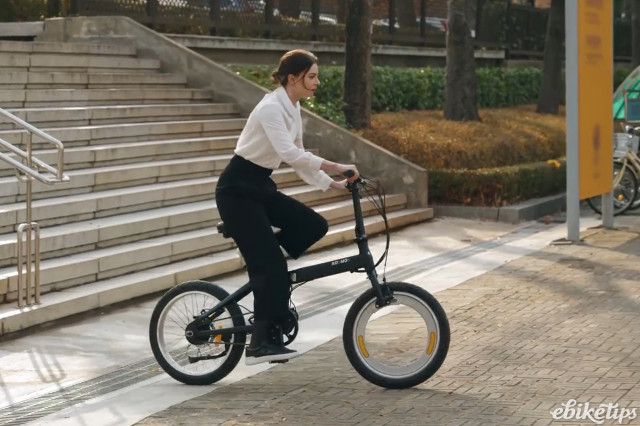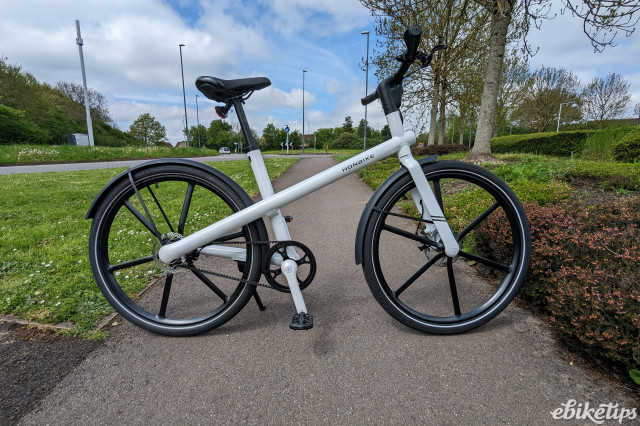Review: Revolutionworks Whippet

Overview
- Cheap and practical
- Relatively lightweight
- Built in the UK
- Awkward cabling
- QC may be an issue
- Not much integration
Revolutionworks made their name a couple of years ago with their Revos kit that Dave is currently reviewing and seems to think is quite nice as a retrofit option. After the success of the Revos, the next step was naturally to move onto a full electric bike, which is where the Whippet comes in.
Where the Revos uses an on-wheel drum system, the Whippet uses a rear hub motor. There is still a certain retrofit quality to the bike’s construction, however. This has some positive impacts but also some negatives, which I will get onto later.
First up, Revolutionworks have deliberately limited the range to allow for a smaller battery and therefore less weight when riding. It means that you can get around 25 miles on a single charge – obviously dependent on hills, assist level, headwind etc. To put that in context, the VanMoof S3 that I recently reviewed had a range of 39 miles and weighed 21kg. This weighs only 13.9kg and gives you 14 miles less.
As I said though, this is a deliberate move. Revolutionworks say that 95 per cent of trips by bike are four miles or less and so, in their words, “Why drag around a big heavy battery when you rarely go further?”
To be honest, I found that the range was between 20-23 miles on my relatively hilly commute. The justification for it might work in smaller cities, but I would definitely have liked to have a little more. My commute is 8.3 miles each way, which meant that I needed to charge the bike every day, which is less than ideal. It also meant that if I decided to travel across London and back from the office during the workday, I wouldn't have the juice to get me home without charging again at work.
However, this shouldn't come as a surprise. An e-bike that comes in at under £1,500 isn't likely to have the biggest battery, so making it light enough to use as a regular bike means that when you run out of juice it isn't too difficult to ride without power.
There were a few times that I found myself riding the Whippet as an acoustic bike, which it does relatively well. Whilst 13.9kg is light for an e-bike, it is fairly heavy for a regular bike, so it’s not great on hills, but on the flat it’s fine. The bearings on the bike are not the best (you can feel the bike slowing without assist as soon as you stop pedalling even on flat and downhills) so acceleration isn’t great, but if you need to limp the last couple of miles home then it’s perfectly doable without power.
You can see the battery level by pressing the button on the battery, which shows either blue, green, or red – blue being fully charged and red being ‘charge now’. You can also see the battery level on the display on the handlebars, but this is a little unpredictable. When I used it, it showed fully charged whenever it was first turned on, which means that you can't accurately tell how much juice the bike has until you've been riding for 10 minutes.
Charging is really easy though. The battery is simple to attach and remove, so I could take it into the office and charge it during the workday or just stick it on charge overnight. Charging takes two hours to get to 80 per cent and I found it was about 2.5-3 hours to fully charge. As there is no permanent indicator of charge, it's difficult to know exactly how long it takes.
Controls on the bike comprise three buttons and eight lights. Five lights indicate the battery level and three indicate the level of assist. The buttons are on/off, turn assist up and turn assist down. It's simple and easy to use, which is appropriate for this simple and easy-to-use bike.
In terms of assist levels, it isn't as powerful as others I have used, but I could get to work without breaking a sweat and as long as I didn't take on any monster hills, it could tackle them without much of an issue. If you do decide to take on more challenging slopes, it will require quite a lot of leg power to get up and you can pretty much see the battery levels draining before your eyes.
The bike is fairly well specced for this price bracket with Shimano MT200 hydraulic disc brakes, a Shimano Altus 7-speed rear derailleur and even a Brooks Cambium C17, a saddle that you would not expect to see on an e-bike at this price. You also get a set of mudguards and Schwalbe Marathon Greenguard tyres, which mean you can use this year-round.
As I mentioned at the start of the review, this feels less like a thoroughbred e-bike and more like a retrofit and this becomes clear when you look at how it's all connected. Essentially most of the wires are connected to the frame with cable ties, which means that you end up with wires pulled and slack or tightness in odd areas. It doesn't impact the ride and over the review period didn’t cause an issue, but with this kind of setup with the cable ties, anybody who ran the old speed and cadence sensors knows that it will damage the paintwork of the frame over time.
There is also something that doesn't impact on the score, but is worth mentioning, which is that this review took longer than expected because I needed to replace the bike twice as it broke in two different ways. Both times these issues would have been covered by Revolutionworks’ warranty, but it suggests that more could be more around quality control and testing to make sure what they're sending out works as it should.
RRP on the bike is £1,499. Given that this bike is rough around the edges and compared to what we have seen from others, this might be a little steep. We recently looked at the Pure Flux One, which is £500 cheaper, has neater cabling and the same range. It doesn't have quite the same level of finishing kit, but for the big elements it's pretty similar. The Crussis e-Cross 1.6 Mens Hybrid meanwhile comes in at the same price but has a range of 50 miles, far more integration, and a better display too.
> 9 of the best electric city bikes from £1,000 to £2,000
Overall there are elements of this bike that I like – notably the weight and the simplicity of the battery – but there are several elements that need to be improved. The range is only 25 miles, which means a charge every time I needed to use it for commuting. Finishing is not great if you're using cable ties to hold wires in place. There are also question marks about the quality control, given that I needed to replace two bikes before I got one that seemed reliable.
2 comments
These were not 'life threatening' both were related to the electrical system not powering the bike.
" I needed to replace the bike twice as it broke in two different ways."
Umm...what?
Is the reviewer going to tell us more such as whether it was potentially life threatening?










